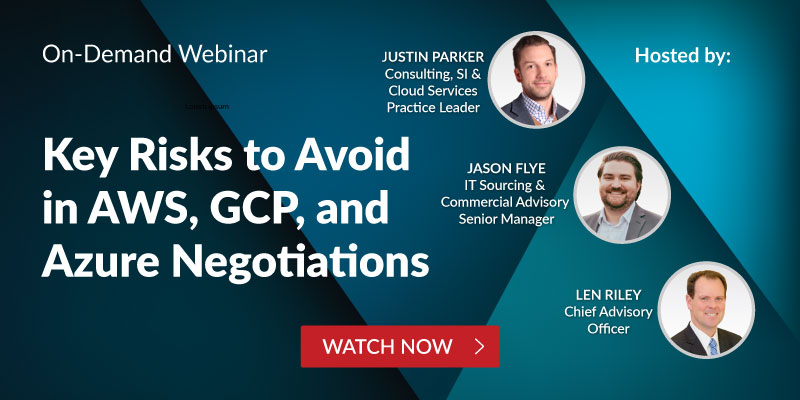- Justin Parker
- Reading Time: 5 minutes

Choosing a hyperscaler includes a series of seemingly unrelated decisions that must be assessed and made with a target end-state in mind. You will likely only get to make this decision once, so you’d better get it right.
As more organizations take advantage of the hyperscalers’ IaaS / PaaS offerings, the need to secure a comprehensive commercial construct has become more important. However, since the focus has traditionally been placed on the architecture, tools, and general capabilities as opposed to the critical commercial elements of an agreement, organizations are left unfulfilled and baffled when they realize their business case has fallen short.
To avoid the fallout of missed business cases and commercial underperformance, those responsible for negotiating an AWS, GCP, or Azure deal should keep these risks in mind:
1. Overcommitting upfront before true utilization is clear
The problem: One fundamental benefit afforded by each hyperscaler is the opportunity to increase your discounts as your environment and compute utilization becomes more predictable, driving your unit costs down by as much 25% – 50% on average. However, hyperscalers will try to position a large upfront commitment over a 3- or 5-year term. In exchange, they will provide increasing discounts and larger incentives.
Unfortunately, organizations become overly enamored by the size of the investments and the discounts being offered and freely overcommit at the outset, restricting their ability to take advantage of other discount opportunities once their usage becomes more predictable (i.e., reserved instances, committed use, etc.). While the overcommit does not entirely prevent them from taking advantage of these discount opportunities, taking advantage of them greatly reduces the likelihood they’ll meet their original commitment, and it puts them in a position of paying for air (or non-use).
The solution: Request three proposals from the hyperscaler(s) establishing the discounted pay-as-you-go amount, the 100% reserved committed amount, and a recommended commitment option to expose the optimization potential, allowing you to better align your upfront consumption commitment:
- Pay-as-you-go. This will be the largest total and likely have the largest consumption commitment and associated discount assumption but will serve as the assumed high watermark for budgetary estimation.
- 100% reserved/committed. This will be the lowest total spend showing the low watermark if all of the assumed compute consumption is “committed,” highlighting the unit rate reduction opportunity. This usually will serve as the no-regrets commitment amount.
- Hyperscaler recommended. Require each hyperscaler to provide their recommended commitment option with associated detail including timing and amount of compute commitments, along with the assumed discount by commitment type. This will typically serve as the upper band of a company’s upfront monetary commitment providing enough committed dollars to obtain market-competitive discounts and incentives with sufficient room to leverage other commitment/discount options to reduce unit costs as consumption becomes more predictable.
2. Not spending enough time on normalizing and validating proposed architecture and consumption volumes
The problem: In real estate, it is all about “location, location, location,” and with hyperscaler commercial evaluations, it’s all about “infrastructure, infrastructure, infrastructure.” However, organizations often spend too little time validating the proposed infrastructure and consumption profile to ensure the proposal meets their requirements. They also err in not validating any discrepancies in assumed compute resources and consumption of those resources.
Ultimately, this leaves organizations assuming the proposed scope across hyperscalers is like-for-like because the organization included their specific requirements within their solicitation or RFP, provided a specific list leading to the selection of what the organization believed to be the lowest cost provider only to uncover they were comparing apples to oranges after it is too late.
The solution: Include the technical team in your evaluation with the responsibility for vetting the proposed infrastructure vs. the requirements and to understand the proposed differences, providing appropriate feedback to the vendor. While it is unlikely to eliminate all differences, at least these differences can be understood and appropriately accounted for.
3. Overlooking the ongoing run rate
The problem: As the size of investments reaches new levels, it’s easy to focus on these one-time investments and lose sight of the real ongoing cost, leaving a very important question unanswered, “What are you left with once these one-time investments are consumed?”
Far too often we see customers focusing on increasing one-time investments while paying little-to-no attention to the ongoing run rate and committed discounting beyond the initial term. Keep in mind, selection of a hyperscaler is a long-term decision and once onboarded, utilization expands exponentially. At renewal time, customers look back and realize what was left on the table and see any negotiated discounting eliminated or they require a substantial monetary commitment increase to maintain.
The solution: Require line-item transparency including specified discounts and architectural and utilization assumptions over a 3- or 5-year commitment period. Pressure test the architecture and discounting, and force stated renewal provisions to lock the discounts beyond the initial commitment term.
4. Excluding support fees from the negotiation
The problem: One thing missing from most hyperscaler commercial responses is the expected support fees and the components of such support services. Far worse is omitting the financial impact of expanding hyperscaler fees on existing support agreements. The prime example is Microsoft’s Unified Support where the support services are tied to a % of Azure spend, usually 10%+, where little link exists between the value received from the services and the ever-increasing cost of such services.
The solution: Put ongoing support services and associated fees front and center, require transparency, and when a vendor says the support fee % is non-negotiable, do not believe them.
5. Undervaluing the impact of competition on the financial proposal
The problem: More and more, cost and commercial competitiveness (not architecture or technical ability) is the deciding factor for an organization’s hyperscaler decision. However, many organizations elect to sole source directly to GCP, AWS, or Azure. While that may be the right decision for various reasons, preexisting relationships among them, customers who sole-source are generally not capturing the highest-level discounts and investments being made available in competitive environments.
The solution: Conduct a streamlined architecture and commercial solicitation process. Hyperscalers are recognizing that companies are increasingly viewing them as a utility and the once-large capability gaps have narrowed. Therefore, hyperscalers are driving customer decisions by making large discounts, investments, and other prizes available to reduce (if not eliminate) setup, migration, and year one compute charges.
However, when the stakes and customer expectations are high, many organizations cannot afford a long RFP process. Given the amount of investments in value-adds made available by each hyperscaler, the opportunity cost for customers of failing to execute a competitive process are equally high.
Therefore, it is recommended to conduct a focused solicitation process with a high degree of communication allowing for appropriate levels of competition without the usual formalities and long duration of an RFP.
6. Excluding your means of supporting and managing the hyperscaler investment (e.g., cloud managed services) from the business case and future-state ops model
The problem: Organizations typically develop their hyperscaler business case assuming their existing team will be able to implement, set up, and provide the ongoing cloud managed services only to realize the skillset gap once it’s too late. Even worse, they sometimes overlook those aspects altogether without realizing the support required or their support options. The result is overshooting the business case, lost opportunity, and more importantly, lost credibility.
The solution: Carefully assess the current capabilities of your existing resources balanced with an understanding of your future-state operating model and do so in parallel with your hyperscaler analysis, selection, and negotiation. This can be accomplished by engaging third-party support providers who deliver a wide array of operational and commercial options ensuring the right information is at hand when making these important decisions.
Your hyperscaler decision is a strategic one and a multi-faceted one at that, including a series of seemingly unrelated decisions that must be assessed and made with a target end-state in mind to be successful.
You will likely only get to make this decision once, increasing the importance of getting it right the first time. Therefore, organizations must understand the extent of the decisions that need to be made, establish the right team to make them, and negotiate a relationship-focused deal recognizing the relationship will extend far beyond the initial term commitment.
Reprinted with permission. © IDG Communications, Inc., 2021. All rights reserved.
Related Blogs
Hyperscaler Renewals: Strategic Takeaways for CIOs and Infrastructure Leaders
3 Benefits of Engaging Hyperscalers When Evaluating SAP RISE
4 Takeaways from Kyndryl’s Forced Migrations to the Public Cloud
About the Author

